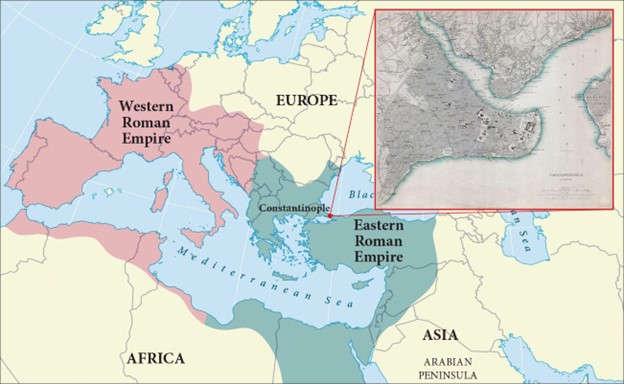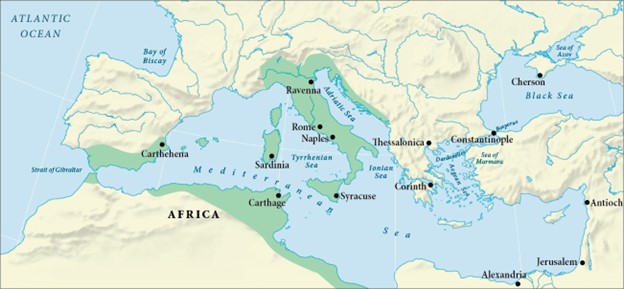33 Eastern Roman Empire: Byzantium
From the third through the seventh centuries CE, the culture of the Roman Empire transformed itself profoundly and in fundamental ways. The rise of Christianity marked a seminal moment, and from the time of the emperor Constantine in the fourth century, the government advocated monotheism, the worship of one God to the exclusion of others. With a Christian government and a new capital at Constantinople in the eastern Mediterranean, the Byzantine Empire grew from the old Roman state. At the same time, the fracturing of the Roman Empire’s government led to various new regional alliances and rivalries. Germanic kingdoms flourished in the West, while the Byzantines attempted to maintain order among the burgeoning Christian population within their borders.
The Roman Empire’s eastward shift epitomized the major cultural changes occurring during this period. Because of these shifts, Late Antiquity has been characterized as a transitional period between the ancient and medieval worlds that occurred from roughly 150 to 750 CE. On the one hand, Late Antique culture remained influenced by the classical past, with the maintenance of certain ancient institutional values. While still calling themselves “Romans,” the Byzantines simultaneously attempted to maintain Christian orthodoxy. On the other hand, the appearance of new religious identities and the breakdown of the Roman state led to conflicts among different regional and cultural groups. The empire’s borders were in constant flux, and its territory slowly diminished as numerous powers vied for regional dominance.

As the Western Roman Empire crumbled, the Eastern Roman Empire, centered in Byzantium (Constantinople), continued to thrive. The Roman state persisted, preserving its classical Mediterranean identity. Late Antiquity (300-600 CE) saw an interplay between continuity and change. Christianity’s growing influence transformed culture, governance, and religion. The Eastern Empire’s bureaucratic system expanded, with wealthy elites dominating government. Urban growth continued, especially in the eastern Mediterranean, where the Christian Church flourished. Byzantium’s unique blend of Roman legacy and Christian innovation characterized this period.
Emperor Justinian (527-565 CE)
Under Emperor Justinian I (527-565 CE), the Byzantine Empire experienced a golden age defined by remarkable achievements in law, architecture, and military conquests. A devout Christian, Justinian commissioned the construction of impressive churches, most notably the Hagia Sophia, which became a symbol of Byzantine engineering and artistic excellence. His legal reforms resulted in the Corpus Juris Civilis (Code of Justinian), a comprehensive compilation of Roman laws that standardized legislation and kept Latin as the language of governance. This codification streamlined the administration of justice and preserved the rich legal heritage of Rome. Additionally, Justinian’s laws addressed crucial religious issues, establishing Orthodox Christianity as the Empire’s official faith. By promoting both Christianity and Roman law, Justinian reinforced Byzantium’s identity as a Christian Roman Empire.
Justinian’s military campaigns sought to reclaim the territories lost by the Western Roman Empire. His skilled generals, particularly Belisarius, achieved significant victories, capturing Carthage from the Vandals in 534 CE and conquering Italy from the Ostrogoths by 552 CE. These successes expanded Byzantium’s borders, restoring Roman control over important regions. Justinian’s reconquests also promoted the spread of Christianity, as Orthodox bishops and missionaries accompanied the imperial armies. Furthermore, the Empire’s renewed presence in the West facilitated the exchange of ideas, cultures, and technologies between the East and West. Byzantium’s influence now extended from the eastern Mediterranean to the Italian peninsula, reviving the legacy of the Roman Empire.

As Justinian focused on conquering territories in Europe, Khosrow I of the Sasanian Empire sought to expand his influence in the east. Initially, Khosrow negotiated peace with the Byzantines in 532 CE, but he soon took advantage of Justinian’s military campaigns and invaded Byzantine lands. The outbreak of war in 541 CE allowed the Sasanians to gain control over Armenia and parts of Syria. Although a truce was established in 557 CE, temporarily halting hostilities, the underlying tensions between the two empires persisted.
Life for a common person in Justinian’s Byzantium (527-565 CE) was vibrant yet challenging. Residents of Constantinople, the capital, lived amid grand architecture, bustling markets, and a rich cultural exchange. People from diverse backgrounds, including Greeks, Romans, Syrians, and Egyptians, interacted daily, creating a dynamic social fabric. Women played crucial roles in both family and society, managing households, participating in religious rituals, and occasionally owning businesses. However, their rights were limited, facing restrictions on inheritance and social mobility. The Orthodox Christian Church dominated religious life, with citizens regularly attending services and observing holy days such as Easter and Christmas. The sounds of hammering, hawking, and chanting filled the air, accompanied by the scents of fresh bread, spices, and incense. Despite Justinian’s efforts to improve infrastructure and public services, hardships remained prevalent, with poverty, disease, and overcrowding affecting many lives.
In the newly conquered territories of Italy, North Africa, and parts of Spain, life under Byzantine rule was complex and often tumultuous. Local populations faced the imposition of Orthodox Christianity, which led to tensions with existing non-Orthodox communities. The Byzantine administrative system replaced previous governance structures, with Greek and Latin established as official languages. While some locals benefited from Byzantine rule, enjoying improved infrastructure and trade opportunities, others endured heavy taxation, forced relocations, and cultural suppression. The Gothic and Vandal populations, in particular, faced significant challenges in adapting to Byzantine dominance. As Byzantine culture spread, local traditions gradually eroded, resulting in a blending of cultures. In cities like Ravenna and Carthage, Byzantine architecture and art merged with existing styles, creating unique cultural fusions. Despite these challenges, the Byzantine Empire’s expansive reach facilitated the exchange of ideas, technologies, and cultures, shaping the Mediterranean world for centuries to come.
Justinian’s reign left lasting impacts on Byzantine society and culture. His architectural projects transformed the landscape of Constantinople, with the Hagia Sophia remaining one of the most iconic landmarks in the world. The Corpus Juris Civilis influenced European law for centuries, shaping legal systems from the Middle Ages to modern times. Justinian’s military conquests and diplomatic initiatives ensured Byzantium’s position as a major power, maintaining its status as a center of civilization. Moreover, his promotion of Orthodox Christianity fostered a strong spiritual identity that shaped Byzantine art, literature, and theology.
The Byzantine Empire in the Middle Ages
After Justinian I’s death in 565 CE, the Byzantine Empire faced a series of formidable challenges that tested its resilience. His successor, Justin II, found it increasingly difficult to maintain the Empire’s extensive borders as external threats loomed larger. The Sasanians to the east began to invade Byzantine territories in Anatolia, while the Avars and Slavs applied pressure on the northern frontiers. This period saw a notable decline in military effectiveness, exemplified by the Empire’s crushing defeat at the Battle of Adrianople in 378 CE, which left lasting scars on the Byzantine psyche. Additionally, the Empire’s finances began to suffer under the strain of excessive spending on prolonged military campaigns and ambitious public works projects. Although the Heraclian dynasty, ruling from 610 to 711 CE, brought a semblance of stability, territorial losses continued to mount, highlighting the vulnerability of the Empire.
During the reign of Emperor Heraclius in the early 7th century, the Byzantine Empire faced increasing pressure from both internal instability and foreign invasion. To respond to these challenges, Heraclius reorganized the empire by creating the theme system—military-civilian provinces designed to improve defense by placing local armies under regional control. These reforms helped the empire survive the initial Arab invasions, but they did not eliminate long-term threats. In 726 CE, Emperor Leo III sparked the Iconoclastic Controversy by banning the use of religious images, or icons, arguing that veneration of images was a form of idolatry. This policy provoked deep divisions within the empire and between the Eastern and Western Churches. While many in the East supported iconoclasm, others—including Western Church leaders—defended the use of images as essential to worship and instruction. The inability of Eastern and Western leaders to communicate effectively or resolve their theological differences worsened the cultural and political rift between them, although the formal schism would not occur until centuries later.
The conflict over icons continued for more than a century. It disrupted religious life, fueled political instability, and weakened unity at a time when the empire still faced pressure from Arab forces. Ultimately, iconoclasm was rejected by the Church at the Seventh Ecumenical Council, held at Nicaea in 787 CE. There, bishops and church leaders reaffirmed the legitimacy of religious images, arguing that icons served as important tools for honoring Christ and the saints—not as idols, but as representations that lifted the mind toward God.
Core Impact Skill — Persuasion
The Iconoclastic Controversy forced a difficult question: Are images a powerful tool for shaping belief—or a dangerous distraction from truth? When Emperor Leo III banned icons, he rejected the use of images to inspire faith, fearing that people were treating art like idols. Others argued that images helped people understand invisible ideas, remember sacred stories, and feel emotionally connected to something larger than themselves. This wasn’t just a religious disagreement—it was a debate about how people respond to what they see.
The Council of Nicaea in 787 ultimately defended the use of religious images, claiming that pictures, like words, could be used to teach and persuade. This controversy helps us see something important: images have the power to move people. Whether in a church, on a coin, a flag, or a protest sign, images can shape what people believe, how they feel, and what they choose to do. They can create unity—or division. They can support authority—or challenge it.
-
Why did some leaders fear the persuasive power of images?
-
What kinds of images are most effective at shaping how people think or feel?
-
Can images be more persuasive than words? Why or why not?
-
Where do we see images being used to persuade people today—in religion, politics, or everyday life?
The Byzantine Empire experienced a brief resurgence during the Macedonian dynasty (867-1056 CE), marked by significant military successes under emperors like Basil II. His campaigns led to the reconquest of Bulgaria and parts of Anatolia, restoring a measure of prestige and territorial integrity to the Empire. However, this period of revival was short-lived, as internal power struggles and rampant corruption began to erode the Empire’s strength. The emergence of external threats from the Normans, Seljuk Turks, and later the Crusaders compounded the Empire’s difficulties, leading to increasing instability. The Fourth Crusade in 1204 CE was particularly devastating, as Latin Crusaders sacked Constantinople and established the Latin Empire, further fragmenting Byzantine territory into smaller entities such as the Empire of Nicaea, Epirus, and Trebizond. Although the Palaiologan dynasty (1261-1453 CE) briefly reasserted Byzantine control over Constantinople, the Empire remained vulnerable and fragmented.
The final blow to the Byzantine Empire came with the Ottoman conquest. Gradually, the Ottoman Turks encroached on Byzantine territory, capturing key cities and threatening the heart of the Empire. Tensions culminated in the siege of Constantinople, where, on May 29, 1453 CE, Mehmed II’s forces breached the city walls, marking the definitive fall of Byzantium. The last Byzantine Emperor, Constantine XI, perished in the fighting, symbolizing the end of an era that had lasted over 1,100 years. Although the territorial existence of the Byzantine Empire concluded, its legacy endured, significantly influencing Eastern Orthodox Christianity, shaping Slavic cultures, and impacting European politics for centuries. The fall of Constantinople not only marked the end of the Byzantine Empire but also ushered in a new chapter in world history, with the Ottomans emerging as a dominant power in southeastern Europe and beyond.
